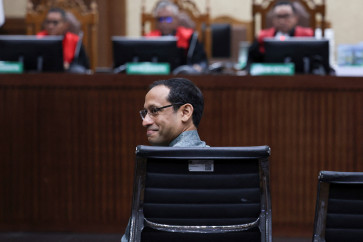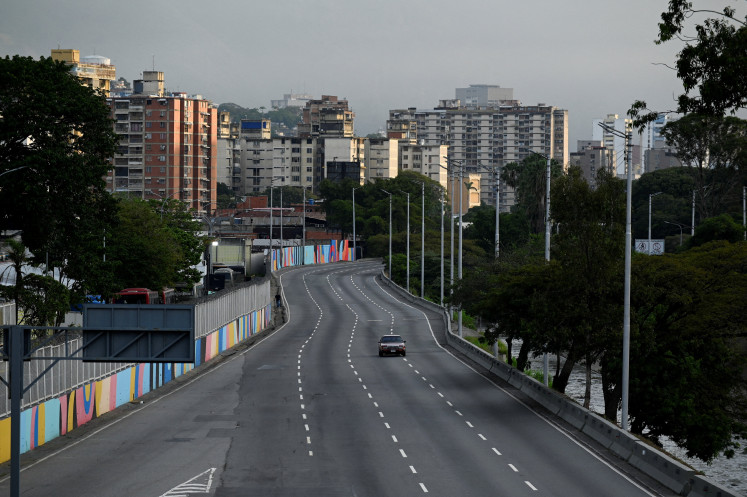Popular Reads
Top Results
Can't find what you're looking for?
View all search resultsPopular Reads
Top Results
Can't find what you're looking for?
View all search resultsLetting others pick up our garbage, leaving the city dirty
What is Jakarta famous for? For some, it's famous for the National Monument (Monas)
Change text size
Gift Premium Articles
to Anyone
What is Jakarta famous for? For some, it's famous for the National Monument (Monas). Others say Jakarta is a haven for cheap and pirated software in the Glodok area. Many say Jakarta is known for its busway, which went into service in 2005.
But there are some people who also say that Jakarta is known for its bad traffic, floods and, of course, trash.
Just look around whenever there are celebrations or major events. From Idul Fitri mass prayers to New Year's Eve celebrations, you can see trash everywhere. It ranges from newspapers and plastic bottles, to half-eaten gorengan (fried snacks of tofu, tempeh or banana).
From my experience taking part in Idul Fitri prayers, people usually carry newspapers to protect their prayers mats from direct contact with the ground. Once the prayers are over, they take back their mats but leave the papers behind. Then dozens of trash pickers - adults and children alike - rush to collect the papers.
Similar scenes occur during the New Year's Eve celebrations in the capital. Ancol Dreamland in North Jakarta, Ragunan Zoo in South Jakarta, and Taman Mini Indonesia Indah in East Jakarta all become mini landfills. Jakarta Sanitation Agency staff had to clean up about 1,200 tons, or 4,900 cubic meters of garbage resulting from the celebrations in those spots. That figure, according to the agency, was slightly lower than last year's 5,000 cubic meters.
Is it difficult to find trash bins along the capital's streets? In some areas, yes. But along major thoroughfares, they're always available, although the number may be less than ideal or necessary.
But littering seems almost a culture for us. My friend criticized me when I told my son to pick up an empty plastic bottle he had just thrown out onto the street. She said, "What's the job of a garbageman if the streets are clean?"
I believe school teachers - especially in kindergartens and elementary schools - always teach students to keep their environment clean. They have special sessions asking the students to clean up classrooms, teaching them to dispose of waste in trash bins, and other activities related to a clean environment. Even at a higher level, like high schools, students are already taught how to make use of organic waste - most of the time, teachers will teach them to make compost.
There are some communities who already apply waste management. People in Banjarsari, South Jakarta, for instance, make use of the waste and turn the organic waste into compost. In Rawajati, also South Jakarta, women make bags from used plastic packaging.
But many of us still have no idea what to do with the household waste. We still rely on garbagemen to pick up our trash. Even if we try to separate our waste in different-colored plastic bags for organic and inorganic waste, trash pickers still mix them up.
Once the trash has been hauled off by the garbagemen, we just know that it ends up at the Bantar Gebang "sanitary landfill" in Bekasi. Although the name seems cool, a "sanitary landfill" is nothing more than a dump site. All efforts taken before our waste reaches Bantar Gebang are useless because there's no waste separation, no special treatment for organic waste and no recycling processes for inorganic waste. There has been no initiative from the government to turn the waste into biogas.
For a big city like Jakarta, with a population of about 10 million, managing the waste is as complicated as managing the traffic. The "sanitary landfill" is apparently not the right answer to overcome the waste problem. Jakarta produces about 6,000 tons of waste per day, according to the Indonesian Forum for the Environment (Walhi). That figure is the volume of 185 Borobudur Temples.
Green activists have made repeated calls urging Jakartans to start treat the waste by themselves. Relying on the city administration will not solve the problem. Unless we start doing something, we will keep seeing trash here, there and everywhere.
- Primastuti Handayani
We invite readers to contribute to this section about things happening in Greater Jakarta. Personal experiences, rants and protests are also welcome. Please send your story to city@thejakartapost.com. The article should be between 600 and 800 words.










